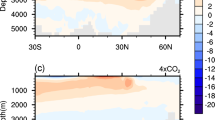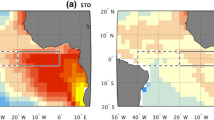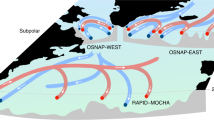Abstract
The Atlantic meridional overturning circulation (AMOC), an important component of the climate system, has only been directly measured since the RAPID array’s installation across the Atlantic at 26°N in 2004. This has shown that the AMOC strength is highly variable on monthly timescales; however, after an abrupt, short-lived, halving of the strength of the AMOC early in 2010, its mean has remained ~ 15% below its pre-2010 level. To attempt to understand the reasons for this variability, we use a control systems identification approach to model the AMOC, with the RAPID data of 2004–2017 providing a trial and test data set. After testing to find the environmental variables, and systems model, that allow us to best match the RAPID observations, we reconstruct AMOC variation back to 1980. Our reconstruction suggests that there is inter-decadal variability in the strength of the AMOC, with periods of both weaker flow than recently, and flow strengths similar to the late 2000s, since 1980. Recent signs of weakening may therefore not reflect the beginning of a sustained decline. It is also shown that there may be predictive power for AMOC variability of around 6 months, as ocean density contrasts between the source and sink regions for the North Atlantic Drift, with lags up to 6 months, are found to be important components of the systems model.








Similar content being viewed by others
References
Ayala Solares JR (2017) Machine learning and data mining for environmental systems modelling and analysis. PhD Thesis, University of Sheffield
Ayala Solares JR, Wei H-L (2015) Nonlinear model structure detection and parameter estimation using a novel bagging method based on distance correlation metric. Nonlinear Dyn 82:201–215
Barnston AG, Livezey RE (1987) Classification, seasonality and persistence of low-frequency atmospheric circulation patterns. Mon Weather Rev 115:1083–1126
Bigg GR, Levine RC, Green CJ (2011) Modelling abrupt glacial North Atlantic freshening: rates of change and their implications for Heinrich events. Glob Planet Change 79:176–192
Bigg GR, Wei HL, Wilton DJ, Zhao Y, Billings SA, Hanna E, Kadirkamanathan V (2014) A century of variation in the dependence of Greenland iceberg calving on ice sheet surface mass balance and regional climate change. Proc R Soc Ser A 470:20130662
Billings SA (2013) Nonlinear system identification: NARMAX methods in the time, frequency, and spatio-temporal domains. Wiley, New York
Billings SA, Wei H-L (2007) Sparse model identification using a forward orthogonal regression algorithm aided by mutual information. IEEE Trans Neural Netw 18(1):306–310
Bryden HL, Longworth HR, Cunningham SA (2005) Slowing of the Atlantic meridional overturning circulation at 25°N. Nature 438:655–657
Buckley MW, Marshall J (2016) Observations, inferences, and mechanisms of the Atlantic Meridional Overturning Circulation: a review. Rev Geophys 54:5–63
Chen S, Billings SA (1989) Representations of non-linear systems: the NARMAX model. Int J Control 49:1013–1032
Chen S, Billings SA, Luo W (1989) Orthogonal least squares methods and their application to non-linear system identification. Int J Control 50:1873–1896
Collins M, Knutti R, Arblaster J, Dufresne J-L, Fichefet T, Friedlingstein P et al (2013) Long-term climate change: projections, commitments and irreversibility. In: Stocker TF, Qin D, Plattner GK, Tignor M, Allen SK, Boschung J, Nauels A, Xia Y, Bex V, Midgley PM (eds) Climate change 2013: the physical science basis. Contribution of working group I to the fifth assessment report of the intergovernmental panel on climate change. Cambridge University Press, Cambridge, pp 1029–1136
Cunningham SA, Kanzow T, Rayner D, Baringer MO, Johns WE, Marotzke J et al (2007) Temporal variability of the Atlantic Meridional Overturning Circulation at 26.5°N. Science 317:935–938
Danabasoglu G, Yeagera SG, Kimb WM, Behrensc E, Bentsend M, Bie D et al (2015) North Atlantic simulations in coordinated ocean-ice reference experiments phase II (CORE-II). Part II: inter-annual to decadal variability. Ocean Model 97:65–90
Frajka-Williams E, Meinen CS, Johns WE, Smeed DA, Duchez A, Lawrence AJ, Cuthbertson DA, McCarthy GD, Bryden HL, Moat BI, Rayner D (2016) Compensation between meridional flow components of the Atlantic MOC at 26°N. Ocean Sci 12:481–493
Gill AE (1982) Atmosphere-ocean dynamics. Academic Press, London, p 662
Guo Y, Guo L, Billings S, Wei H-L (2015) An iterative orthogonal forward regression algorithm. Int J Syst Sci 46(5):776–789
Hodson D, Sutton R (2012) The impact of resolution on the adjustment and decadal variability of the Atlantic meridional overturning circulation in a coupled climate model. Clim Dyn 39:3057–3073
Jackson LC, Peterson KA, Roberts CD, Wood RA (2016) Recent slowing of Atlantic overturning circulation as a recovery from earlier strengthening. Nat Geosci 9:518–522
James G, Witten D, Hastie T, Tibshirani R (2013) An introduction to statistical learning, vol 6. Springer, New York
Karspeck AR et al (2015) Comparison of the Atlantic meridional overturning circulation between 1960 and 2007 in six ocean reanalysis products. Clim Dyn. https://doi.org/10.1007/s00382-015-2787-7
Kennedy J, Morice C, Parker D, Kendon M (2016) Global and regional climate in 2015. Weather 71:185–192
Marshall A, Bigg GR, van Leeuwen SM, Pinnegar JK, Wei H-L, Webb TJ, Blanchard JL (2016) Quantifying heterogeneous responses of fish community size structure using novel combined statistical methods. Glob Change Biol 22:1755–1768
Prior J, Kendon M (2011) The UK winter of 2009/2010 compared with severe winters of the last 100 years. Weather 66:4–10
Ramsey JB (1969) Tests for specification errors in classical linear least-squares regression analysis. R Stat Soc 31(2):350–371
Smeed DA (2017) The RAPID challenge: observational oceanographers challenge their modelling colleagues. Ocean Chall 22:16–18
Smeed DA, Smeed DA, McCarthy G, Cunningham SA, Frajka-Williams E, Rayner D, Johns WE, Meinen CS, Baringer MO, Moat BI, Duchez A, Bryden HL (2014) Observed decline of the Atlantic meridional overturning circulation 2004–2012. Ocean Sci 10:29–38
Smeed D, McCarthy GG, Rayner D, Moat BI, Johns WE, Baringer MO, Meinen CS (2017) Atlantic meridional overturning circulation observed by the RAPID-MOCHA-WBTS (RAPID-Meridional Overturning Circulation and Heatflux Array-Western Boundary Time Series) array at 26 N from 2004 to 2017. British oceanographic Data Centre—Natural Environment Research Council, UK. https://doi.org/10.5285/5acfd143-1104-7b58-e053-6c86abc0d94btett
Tett SFB, Sherwin TJ, Shravat A, Browne O (2014) How much has the North Atlantic Ocean overturning circulation changed in the last 50 years? J Climate 27:6325–6342. https://doi.org/10.1175/JCLI-D-12-00095.1
Wei H-L, Billings SA (2008) Model structure selection using an integrated forward orthogonal search algorithm assisted by squared correlation and mutual information. Int J Model Identif Control 3(4):341–356
Wei H-L, Billings SA, Balikhin MA (2004a) Prediction of the Dst index using multiresolution wavelet models. J Geophys Res Space Phys 109(A7):A07212
Wei H-L, Billings SA, Liu J (2004b) Term and variable selection for non-linear system identification. Int J Control 77(1):86–110
Zhao Y, Bigg GR, Billings SA, Hanna E, Sole AJ, Wei H-L, Kadirkamanathan V, Wilton DJ (2016) Inferring the variation of climatic and glaciological contributions to West Greenland iceberg discharge in the twentieth century. Cold Reg Sci Technol 121:167–178
Acknowledgements
We thank the UK RAPID programme for providing the AMOC data at http://www.rapid.ac.uk/rapidmoc/. GODAS data was provided by the NOAA/OAR/ESRL PSD, Boulder, Colorado, USA, from their Web site at http://www.esrl.noaa.gov/psd/.
Author information
Authors and Affiliations
Corresponding authors
Ethics declarations
Conflict of interest
The authors have no financial conflicts of interest in carrying out this research.
Appendix: Model averaging
Appendix: Model averaging
One of the model performance metrics, RMSE (root mean squared error), given in Table 2 is used to implement a model averaging scheme. Note that the RMSE values for the three models are MSE1 = 2.2382, MSE2 = 2.0761, and MSE3 = 2.2852, respectively. Using these values, we define the following parameters:
Let \( \hat{y}_{1} \), \( \hat{y}_{2} \), and \( \hat{y}_{3} \) be the predicted output values by the three models of the three cases in Table 2, the model averaging prediction is defined as:
The three model performance metrics, ME, MAE, and RMSE produced by the model averaging prediction are listed in Table 5.
The graphical illustration of the model averaging prediction performance is shown in Fig. 9.
Rights and permissions
About this article
Cite this article
Ayala-Solares, J.R., Wei, HL. & Bigg, G.R. The variability of the Atlantic meridional circulation since 1980, as hindcast by a data-driven nonlinear systems model. Acta Geophys. 66, 683–695 (2018). https://doi.org/10.1007/s11600-018-0165-7
Received:
Accepted:
Published:
Issue Date:
DOI: https://doi.org/10.1007/s11600-018-0165-7





